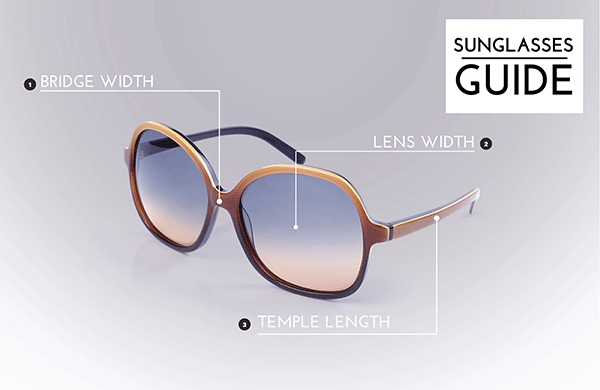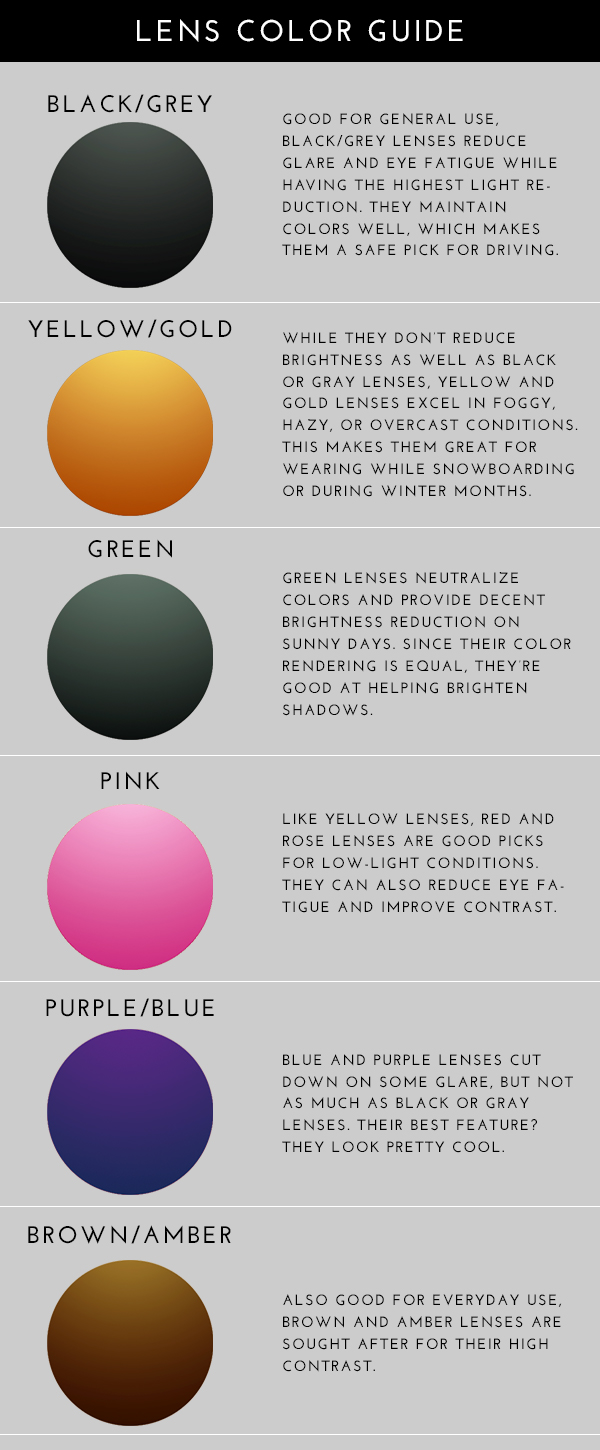
The right pair of women's or men's sunglasses can do a lot for your look, but there are many facets you need to consider when comparing different types of sunglasses. In this guide, we'll help you determine the right size, fit, and shape for your face—making online orders a breeze.
Sizing, Measuring, and Fit
Shopping online opens up the world's largest inventory of sunglasses—but since you can't try them on first, having a precise size measurement is essential. Three key frame measurements determine the size of a pair of sunglasses:

- Bridge width: typically ranges from 14mm to 24mm
- Lens width: typically ranges from 40mm to 62mm
- Temple length: typically ranges from 120mm to 150mm
Please note that these measurements are strictly for determining fit, not sunglasses coverage (there's plenty of oversized-style sunglasses made for smaller faces). Just remember: the larger the face, the larger the measurement.
How to Measure Your Face
If you already wear eyeglasses, you likely have a handy shortcut. Look on the inside of the temple arm of your glasses for three numbers indicating frame dimensions. Those numbers are:
[lens width] x [bridge width] x [temple length]
Alternatively, your frame may have lens width and bridge width printed on the nose bridge. When shopping for sunglasses, use these dimensions as your guide. You'll have a leeway of 2 millimeters for each dimension, so a good fit doesn't need to be exact.
Measuring Bridge Width
Examine the bridge of your nose in the mirror. Where does it start? How wide or skinny does it get? Next, take a selfie of your side profile.
- If your bridge is low (level or below your pupils) and skinny, a small bridge size will work best
- If your bridge is high (above your pupils) and wide, a large bridge size will work best
- For any other combination of attributes, a medium-range number should provide a comfortable fit
Measuring Lens Width
While looking in the mirror, hold a ruler up so that it lines up with your temples. Measure the distance between them, then subtract 6 millimeters (the total average for the endpieces) and your bridge measurement. Halve the remainder and you have your lens width.
Measuring Temple Length
Temple arm length has the least variance of the three dimensions, so it's less important to get an exact measurement. Anything from 135 to 145 millimeters should be a safe bet.
Finding the Right Fit
Sure, sunglasses with huge, round lenses might make you look like a Hollywood star trying to conceal their identity, but they might also conceal the flattering aspects of your face, or more importantly, feel uncomfortable. Check out the table and graphics below to get a better idea of which styles fit your face like a glove.

Frame Material
Choosing a durable frame means you won't need to buy a new pair after every accidental bump. Read on to learn more about some of the frame materials you're likely to encounter when shopping for different types of sunglasses.
Metal

Most often seen on casual styles such as aviators, metal frames are typically more malleable than their plastic or synthetic counterparts. This flexibility means they comfortably fit a wide variety of face shapes. They're also usually more expensive and less durable than shades made of other materials.
Plastic

These frames are generally cheaper and more lightweight than other types, but they're still relatively impact-resistant, making them great for comfortable, all-day wear. Here are a couple varieties you're likely to see while shopping:
- Polycarbonate: A harder version of plastic, polycarbonate can weather tough use. Sunglasses made with polycarbonate are typically suitable for everyday and active wear. They'll stay in one piece when stashed in a purse or backpack, and their durability also makes them a great choice for kids.
- Acetate: Acetate frames are a bit lighter, yet more durable than standard plastic sunglasses. They can also come in many different designs, since their colors are imbued into the material itself instead of painted on.
Nylon

If you're looking for sunglasses to wear while playing sports or enjoying outdoor activities, nylon-frame shades might be your best option. These frames stand up to everything from drops and bumps to changes in temperature that would normally alter the flexibility of frames made from other materials.
Lenses
Lens characteristics such as material and color can have a great impact on how sunglasses will perform in different lighting conditions and environments. Find out which material and color works best for you:
Materials
- Polycarbonate: These lenses are lightweight and tough, and they offer good optical clarity. They also resist shattering more effectively than glass lenses, making them a good pick for active wear.
- Acrylic: These lenses won't give you the impact-resistance of polycarbonate or optical clarity of glass, but they're generally less expensive, so they're a good choice for shades you'll only be using occasionally.
- Glass: Glass lenses give you the highest level of clarity, and they resist scratching better than most materials. They do tend to be heavier than polycarbonate lenses, and they can form spiderweb-like cracks if dropped.

Protection
Whether you're a machine operator who needs shades that'll minimize glare, or one of those fashionistas who wears sunglasses indoors, these key lens features can keep your vision clear and your eyes protected.
UVA and UVB Lenses
UV-protected lenses guard your eyes from harmful ultraviolet rays, and they also keep the skin surrounding your eyes safe from premature aging caused by sun exposure. To determine what type of UV protection a pair of sunglasses provides, look for a tag or sticker on the frame—if it doesn't say the lenses block 100% of UVA and UVB rays, then they probably don't.
Polarized Lenses
Polarized lenses are made with a chemical film that helps eliminate glare. This makes them especially helpful for driving on cloudless days or keeping your eyes comfortable while on a boat or at the beach. So how does polarization differ from tint? Tinted lenses make what you see appear less bright, but they won't cut down on glare if they're not also polarized.
Gradient Lenses
Gradient lenses are just what they sound like: lenses that change their tint over a gradient from top to bottom. This helps them adjust to a wider array of lighting conditions better than solid-tint lenses can.
Scratch-Resistant Lenses
If you know you'll be keeping your sunglasses loose in a backpack or need a pair to wear during athletic activities, it's worth it to consider lenses with scratch-resistant coating. Not only will they keep your shades looking good, but they'll also ensure your vision isn't obstructed by scratch marks.
